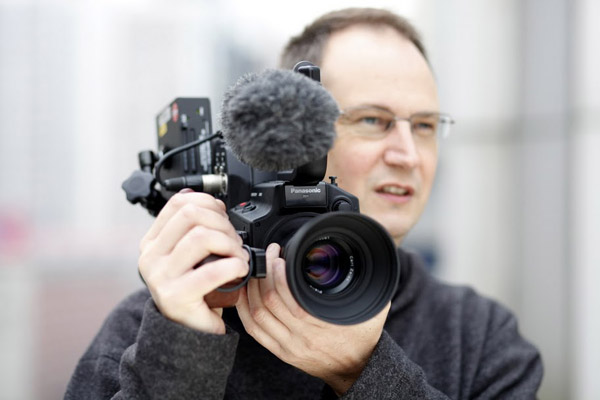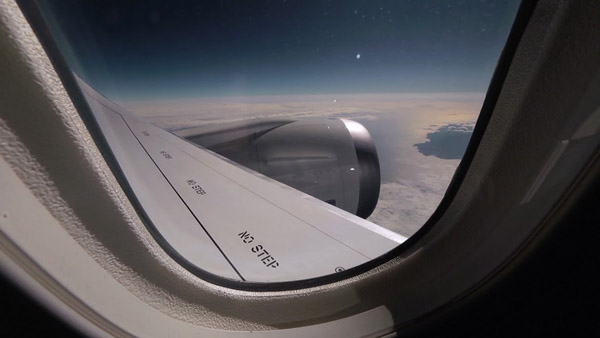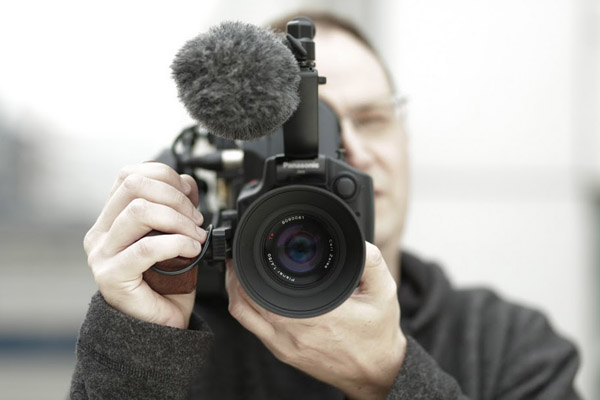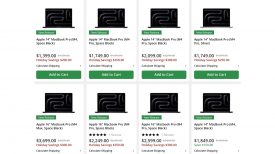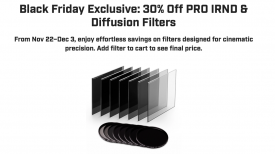By Andy Portch
A full size HD broadcast camera is picture perfect and looks impressive. The large camera also screams “TV Crew” and too often gives a ‘warped’ view as people react to the big camera or simply turn it away. My previous experience shooting news with the Canon 5D mkII was a visual triumph, but the paraphernalia and workflow was overwhelming. I want to keep the big camera craft, but in compact form. Twelve months ago the Micro four thirds (MFT) system caught my eye. The Panasonic AF101 and smaller GH2 stills/video hybrid cameras are cross compatible, sharing lenses and shooting the same AVCHD format. The AF101 is also significantly cheaper and smaller than the alternative Sony F3.
I went ahead and purchased the AF101 (AF100 in the USA) because it has all the video camera features: Neutral Density (ND) filter wheel, XLR audio inputs, Variable Frame Rate, SDI output and a dial in white balance. The AF101 ND filter wheel is the critical plus factor for me. I would not recommend any video camera without built in ND filters. I almost love the AF101 except for this – focus, focus and focus. Achieving critically sharp images is extremely difficult. I lobbied Panasonic hard for a better Electronic Viewfinder (EVF) and one-to-one pixel mapping magnification to no avail. I guess it will likely be in Panasonic’s next large sensor camera and I’ve now accepted the need for an external Zacuto EVF in my kit.
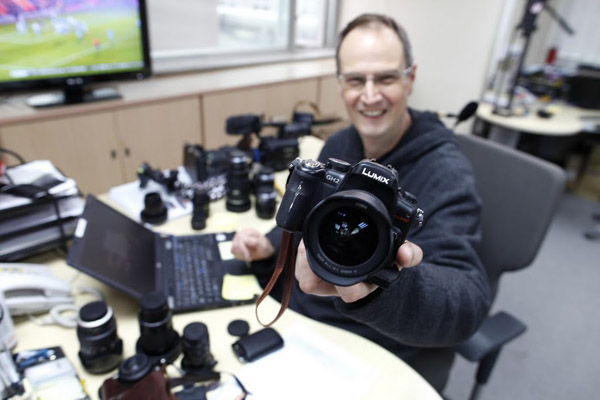
Working alongside my AF101 I have the GH2 which is small and discrete, with improved video functions over my old Canon 5D mkII. The GH2 has a crisp EVF with image magnification which means you don’t need an LCD loupe. Depth of field is shallow, but more manageable for video than a full frame sensor. I can still use manual full frame lenses with low cost adapters. In fact the beauty is I can carry the same creative stack of lenses for use with my GH2, GF2 or AF101 video camera.
My trusty Billingham bag (16inches/40cm long) was the defining maximum size for the AF101 rig. If the compact camera concept ended up the same size as my shoulder mounted P2HD ENG camera then I’d failed. It had to be ready to record straight from the Billingham bag in broadcast HD quality. Plus I wanted to be able to put it either on my shoulder, on a tripod or on a flat surface without it falling over or needing any further assembly.
I’ve used the combination of GH2 and AF101 extensively this year and to illustrate various points and lessons learned about the cameras’ use I’m going to refer to a portfolio of five news stories which I’ve done. Each is shot with Holly Williams, my correspondent in the Sky Beijing bureau. She has supported my tireless and sometimes tiresome quest for better imagery:-
Chinese Hackers: (Shot with AF101 and Zeiss/Contax CY prime lenses)
EXTRACT Sky News Chinese Hackers and Baby Buying stories from Andy Portch on Vimeo.
This was an alarming story given the ease this young computer hacker accessed our email and credit card passwords! I shot in a darkened room with a bit of Kessler Pocketdolly slider movement. I loved it. Despite recording in AVCHD I had comments from colleagues about how wonderfully sharp it was.
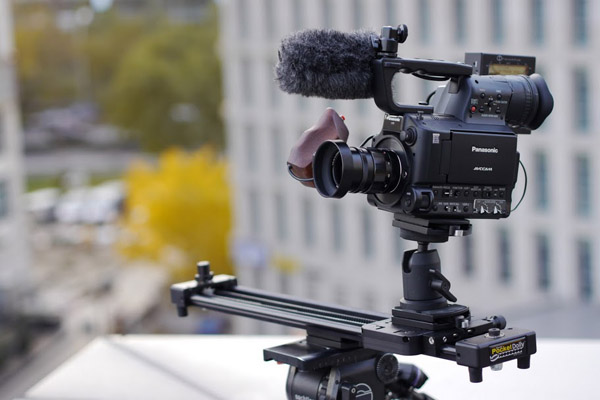
Most manual focus stills full frame 35mm lenses are perfectly adaptable to MFT with a two times magnification factor (x1.86 with GH2). The Zeiss CY are easily cine modified, aperture de-clicked and damped. They have a comfortable focus throw and gorgeous Zeiss image quality. The old Zeiss CY 50mm f1.4 is a gem. Canon FD is also a good manual lens option if you don’t have the budget for Zeiss. More expensive adapters now exist for Canon EF lenses with their electronic aperture. I haven’t personally used Nikon lenses because they focus in the opposite direction.
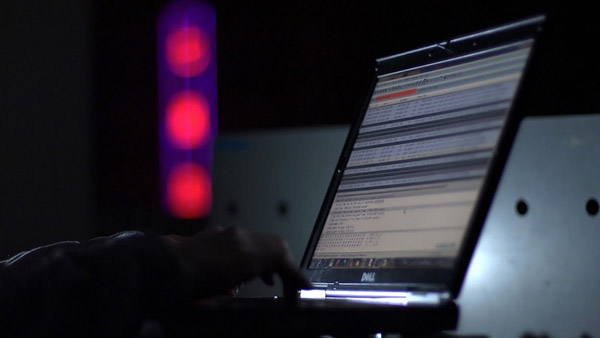
Shooting in low light with raised ISO has not been a problem for me with the AF101. I did one shoot in a very dark whisky bar and was pleased how little video noise showed in the shadows. However the AF101 does not handle highlights well. In it’s Cine gamma modes camera knee is disabled. Unless blown highlights are out of focus they look awful. Underexpose a touch and the problem goes away. I’ve tweaked my Cine Gamma settings, and still have fairly vivid colour and contrast. I do grade, but if I like the ‘look’ straight from the camera I have the option not to grade for a rush news edit.
Ergonomically the camera had been proving hard for me to handhold but I had a ‘eureka’ moment when I started using a side support bracket and wooden handle/video trigger made by Olof Ekberg of Westside AV. The AF101 top and side handles unscrew to add accessories or brackets very easily. Not only was Olof’s side handle more comfortable, but at last I knew where the record start/stop button was. I’m also using a short padded tail plate to the side bracket that places the AF101 camera on my shoulder, but without moving the centre of gravity forward. It makes a real difference when trying to get stable handheld shots.
Baby Buying: (AF101 and Nanoflash recorder)
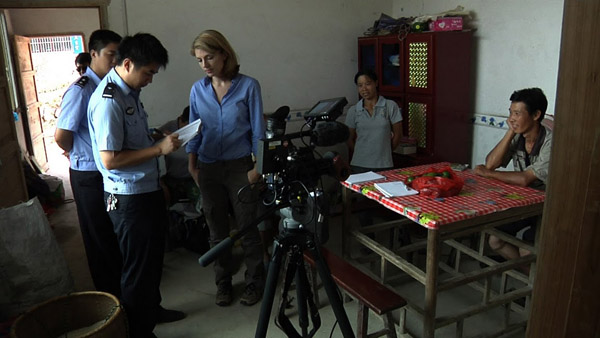
I shot sequences for a story about a Chinese baby buying scandal, mainly with a Voigtlander Nokton 25mm f0.95 and Zeiss primes. Again the Kessler Pocketdolly gave lots of positive feedback. The slider is a creative bonus, but when your interview subject is jumpy and really wants to head for the door, it takes nerve to create steady moves. There is a ‘should we use a slider for news’ debate (not least on this very blog). I use the slider with an awareness of when perhaps it is not appropriate as much as when it is physically possible.
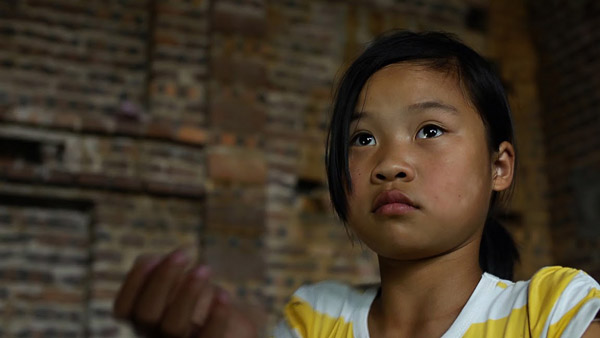
The compact system is extremely lightweight and my back loves it. Lighter cameras mean lighter accessories. Everything on my AF101 and GH2 has the same Manfrotto 394 quick release plates. I can move easily from one piece of kit to another. For a tripod I use a Miller DS10 head on Solo carbon fibre legs; lighter, higher and lower than my regular Sachtler Video18P. Along with it I carry the compact Kessler V2 Pockedolly that works a treat (especially now I have fitted the optional carriage brake). If I’m in a controlled environment then I use the SmallHD DP6 which is a rugged and sharp field monitor. A single Canon LPE6 battery will last a morning on the DP6. The only downside to my dp6 is a yellow cast when you first switch on.
China Tibetan region: Self Immolating monks. (GH2 video DSLR)
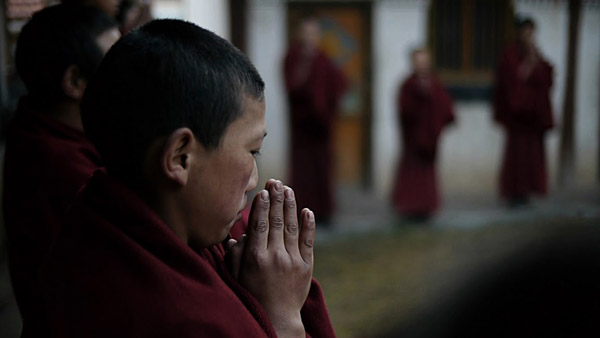
I’m used to working as a journalist in China – being harassed and my work interfered with by police and plain clothes thugs. The GH2 has shown its value, getting quality video in sensitive locations. (Its baby brother the GF2 has also been used by out team, including for a Bangkok ‘Lady boys’ documentary). In Sichuan province the police were all over us. We did every dodge in the book and over a couple of days managed to get images of temples and monks to tell this story. We also shot material we could not broadcast for fear of what would happen to those we’d met. Security is so tight in the Tibetan areas of Sichuan province. Monasteries have police stations and the authorities knew exactly where we’d been. We were soon sent to the airport.
EXTRACT Sky News Stories Tibetan Monks and Boeing Dreamliner from Andy Portch on Vimeo.
For this story the GH2 did its job, but the lack of built in ND filters was a mess. I’d opted against the variable ND (which I’d found soft on my 5DmkII) in favour of screw in ND8 (3 stop) filters. I thought I’d be either outside or inside for lengths of time. In fact it turned into a real pain as we repeatedly sneaked quickly from indoors to outdoors and vice versa. This mean’t I had a lot of panicky filter changes. That said it wasn’t just my GH2 that had problems with the light. It is unbelievably bright in the mountains and I also had a tiny Sony AVCHD Handycam (with IR capability for night vision) with me. It couldn’t stop it’s aperture down enough to shoot outdoors at noon! I did use some shots from that camera and had a lot of work to match them to the superior GH2.
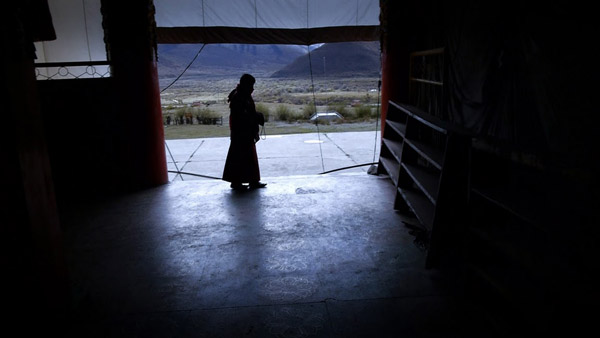
Another factor with the GH2 was that the small size made it hard to hold without vibration from the blood pumping through your hands. Admittedly I was a bit stressed, but these are visible bumps in the shot even with the wide angle lens fitted.
For this assignment I also used the Voightlander 25mm Nokton lens wide open at f0.95, at least two f-stops wider than I would normally do. It was late dusk and I was hand held. To find the narrow plain of focus l found I had to sway gently back and forth. The GH2 is a surprisingly good low light performer. You can crank up the ISO and use the ‘nostalgia’ film mode (which has nothing to do with nostalgia) but lifts the shadows considerably. Strangely I find the GH2 easier to focus than AF101. The one press EVF image magnification gives instant focus confidence and you can hit record.
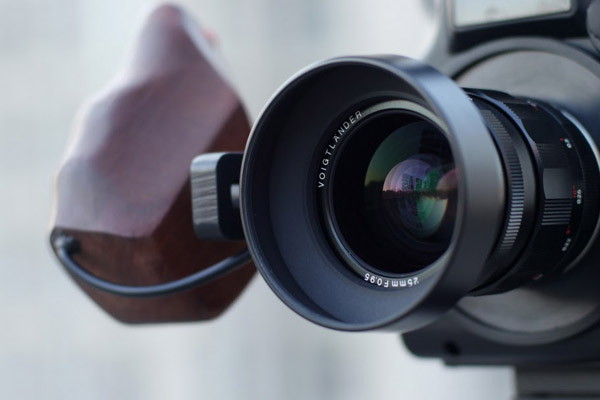
After the pain of 5D mkII audio I have largely stopped using a mini audio adapter with the GH2. I let the camera record with manual levels displayed in the viewfinder. Simultaneously I use a separate Olympus LS11 audio recorder with Tram lavaliere mic placed on my reporter or talent. It can record for eleven hours and it is easy to sync image and audio afterwards especially if you have Plural Eyes software.
Boeing Dreamliner Inaugural flight: (AF101 with Nanoflash)
My 7-14mm Lumix F4 got a good outing on this trip. The lens is lots of fun (as long as it’s bright) and it’s easy to get extraordinary images. Holly’s ‘piece to camera’ on the jet was centre frame, filmed from one metre away seated across the aisle. The shot was so wide it included two passengers seated either side! The only problem was choosing an angle not to make her look cross eyed! The opening sequence has banding from flash photography which the CMOS chip struggles with, but nowhere near as bad as the 5D mkII flash banding.
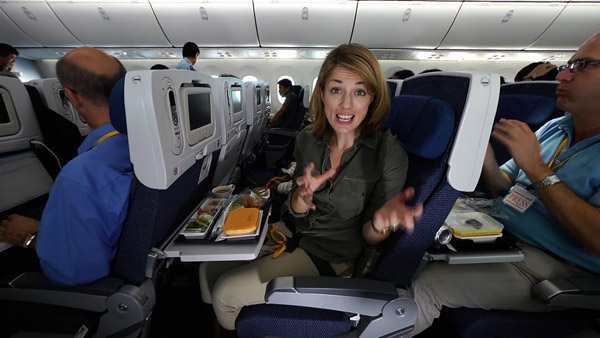
The Micro Four Thirds system is dominated by Panasonic and Olympus but other manufacturers have thankfully joined in and new lenses are popping up. I’ve ordered the new SLR Magic 12mm F1.6 with cine aperture ring (with no click stops). The Voigtlander Nokton 25mm F0.95 has already become one of my firm favourites. De-clicking is possible, but less straight forward as the aperture ring is at the front. I like the Nokton and it’s images sit well alongside the Zeiss.
The results from Lumix and Olympus lenses are mixed. They feature some if not all of these issues – clicking electronic apertures, twiddly control wheels, zooms that aren’t parfocal (even if they’re supposed to be), latency with focus by wire and focus rings that spin endlessly. I hope the promised 2012 Lumix X Pro 12-35mm and 35-100mm are fast and sharp zooms. For now beware lenses with a tiny focus throw. The Olympus 12-60mm f2.8-4 for example has a great range, manual focus markings, but focuses from infinity down to one metre with just one centimetre throw. Compare that with a ten centimetre throw for the same focusing distance from my broadcast camera’s Canon HJ22 lens. I know some people use follow focus devices, but again that defeats my compact goal.
The Dreamliner by the way turned out to be identical to any other plane. I called it the ‘Binliner’, with slightly larger overhead lockers. To think Boeing was aiming supersonic before 9/11.
Bangkok floods: (AF101 with Nanoflash)
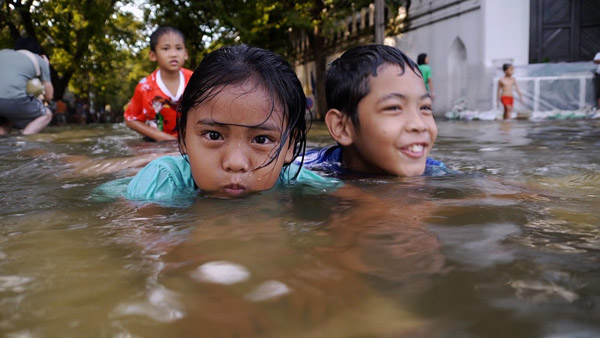
This was a regular news scramble. I had to shoot, load, edit and transmit quality daily pieces by lunchtime every day. Following the packaged reports with hourly live crosses with Holly and then another shoot to update the package for later. The AF101 has analogue video out, HDMI and HDSDI output – but no firewire. The system we use for live satellite reports from a Mac needs a firewire input. Thankfully the Canopus ADVC-55 analogue to firewire box bridges the gap for streaming lives.
EXTRACT Sky News Bangkok Floods stories from Andy Portch on Vimeo.
Lens juggling standing in flood water added a frisson to changing lenses. I’ve adapted a small bum bag with padded compartments that holds three or four lenses and those are the ones I have on the go. Rubber lens hoods are fitted to all my lenses to speed up changes. In Bangkok I tried using the 14-140mm Lumix zoom with image stabilizing, but had trouble getting it sharp. Autofocus I haven’t really explored – I can’t bring myself to trust it. There is focus assist on the AF101, which puts a red fringe to whatever is sharp (or as I’ve found almost but not quite sharp). The AF101’s built in EVF and LCD ‘detail’ feature helps, but should not to be used at the same time as red focus assist.
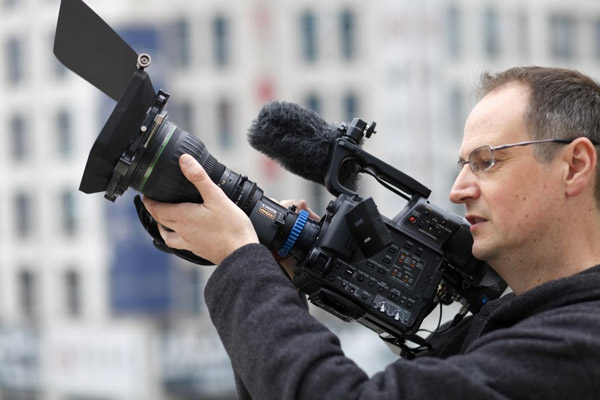
The lens mount of AF101 is rated for 1kg. Fast and heavy Canon and Olympus telephoto zooms need supporting. As did my broadcast Canon HJ22 and HJ11 lenses I tried with an adapter. In reality I don’t want 15mm rails on my compact rig, so lens choice had to be sub 1kg. The Olympus Zuiko 50-200mm f2.8-3.5 is my heaviest lens and is sharp and good to focus, but lacks image stabilising and aperture ring.
I did get more daring shots with the lightweight AF101 than I would from my big news camera. Instead of a rig I used a Gorillapod with Manfrotto ball mount head as mini brace either on the shoulder or wrapped around things, even at water level.
So what can you do with the AF101 and GH2?
Both record to SDHC cards in AVCHD format up to 24Mbps. I conducted comparisons viewed on a 25 inch HD monitor with the same scene recorded with AVCHD and HD broadcast codecs. Most viewers could not tell the difference, some chose AVCHD over HD codecs and only a single video engineer spotted the higher bitrate HD codec footage.
AVCHD does not meet the minimum 50Mbps specified by most HD broadcasters – which is a pain! For me the answer has been the low power Convergent Nanoflash external recorder powered together with the SWIT S-8BG6 camera battery. The battery has an auxiliary socket and a single battery powers camera and Nano flash for hours. The Nano has power save mode, so you don’t have to keep plugging/unplugging. The resulting Nano flash XDCAM HD422 files are recorded to CF card in either MXF or .MOV. I did have a Nanoflash fail on location. A capacitor failed and was repaired by Convergent Design who said it was the first of four thousand units to fail this way. The Nanoflash is attached by locking arm to my AF101 side bracket and sits there perfectly out of the way.
Shooting a progressive image rather than interlaced looks less newsy. Some prefer this, but I think it makes the footage less ‘real’ for viewers watching our news broadcasts and so for now we have reverted to interlaced shooting. The compact AF101 camera is not suited to every shoot. Long lens stuff is most difficult. I wouldn’t choose it for a live press conference or a shoot over the North Korean border. Juggling lenses is troublesome. I started dreaming about an old cine camera revolving lens turret! I need to think clearly what shots I want and go after them with a specific focal length. I guess photographers coming to video would have two GH2 bodies with different lenses as they do for stills (I’m tempted!).
In conclusion with Micro four thirds I can do high quality work with a system that doesn’t cost very much. It is challenging for news, as is shooting anything with shallow depth of field. The beauty comes from the prime lenses, but for recording news ‘fast’ zooms are still required. I miss the ease of function and speed of a regular TV camera and broadcast zoom lenses. On the other hand there are creative benefits from that large MFT sensor. I hope it makes my pictures better and I love walking out the door with my Billingham bag. At least I don’t look like a TV cameraman.
Andy Portch is a senior cameraman for Sky News based in Beijing.
He is a broadcast pioneer helping to develop and shape camera and news gathering technology and has spent more than twenty years covering global news stories. A career Andy sums up as hard to beat – “It is a privilege to meet the people I’ve met, to travel to the places I’ve been and to see the extraordinary things I’ve seen.”

